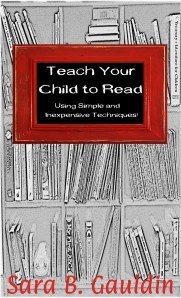Teach Your Child to Read: How do I put it all together?
If you have been reading to your child throughout this process, if your child knows the letters and letter sounds, at least thirty sight words and can identify word family words, then it is time to begin to read authentically. There is no magic trick to make this transition. If a child has learned all the essential components to reading, they are ready to apply them. This can be a bit intimidating at first. Children need support during these early reading attempts (and throughout their school careers).
Before you hand your child a book, make sure the material is appropriate for his or her reading level. If your child is school aged you may try asking your child’s teacher what your child’s reading level is. They will most likely be able to give you an immediate answer. If you are not sure, then assume that your child is beginning on a kindergarten or primer level. It is better to start too low and build confidence that too high and build frustration.
Find a few books that look fairly simple. You want to find interesting books with good pictures. Try to find materials that are about topics your child is already interested in. You want to foster a true love of reading my making the experience pleasant and inviting. If you do not have a supply of reading material at home, take a trip to your local library. Your librarian will be able to help you choose books.
To find a better picture of specifically what reading level a certain book is meant for, you can use the Accelerated Reader tool http://www.arbookfind.com/UserType.aspx to look up the book by title or author and find a number ranking. Use the parent login. For example, I keyed The Very Busy Spider into the search box. The site returned the results that read IL: LG – BL: 1.3 – AR Pts: 0.5. You are looking for the number 1.3. This indicated that a child reading on a first grade, third month level should be able to read the book with support without becoming frustrated. The AR Pts. notation is only referring to how many points a child would earn if they took a quiz on the book at a participating school. If your child is just learning to read, stay in the 0. 1 to 1.5 range of books when you have your child read to you. It is fine to check out more difficult books to read to your child. Their listening comprehension should be much higher than their ability to read independently.
Before reading any book, talk about the cover with your child. Read them the title and author’s name. Talk about the picture. Ask, “What do you think this book will be about?” or “Do you think this book will be real or make believe?” Listen to your child’s comments about the cover and let them lead the conversation after they have answered your questions. Have your child look at the pictures through the book. Talk about any concept that they can’t identify. Comment on the characters and their expressions. What kind of mood is the character in? Pay close attention to pictures showing action. Have your child make predictions about what they think the story may be about.
With a brand new reader it is permissible to read the story to the child after your initial picture walk. This is also viable for readers who are a little older and who are struggling. When a child’s confidence in their ability to read a book is low, pre-reading the story to them can give them the peace of mind of not charging headlong into unknown territory.
Most readers will be ready the “echo read” the story after the picture walk and possibly being read to. As the name suggests, echo reading is when the adult reader reads a phrase, then the child says the words aloud after the adult while tracking each word with their finger. Do not attempt to squeeze in long sentences into one chunk. A child has a short working memory. A four or five word section is enough for one piece. I use the amount I can say in one breath as an indicator. As you read, model the way you would like for your child to read. Add expression and emotion. Honor punctuation, it is important when gleaning meaning from the text. Do not be tempted to read word by word or in a robotic way. Remember, you are competing with screen time, if you bore the child; you lose their effort towards anything but dodging the experience.
After reading the story put it aside. Revisit again in another sitting. It is important for children to feel joy in the time spent reading and not feel they are being punished in any way. It is a valid method to ask the child to choose a second story to read together after the adult chosen selection. If you allow your child to choose, ask him or her to choose from the titles they have already read. By re-visiting stories and repeated reading your child will gain independence, confidence and most critically reading fluency.
After more than one sitting with an echo read your child should be ready to read chorally. This means that you both read the story together. This gives the beginning reader a little support for confidence while allowing them a bit more accountability while they practice. Again, have your young reader put their finger under each word as they read. This gives you an idea if they are authentically reading the word they are saying and makes them accountable to match the words they are saying with the ones they touch.
When you see that your child is pulling away as they read it is time to retire to “active listener” (at least in regard to the story they have been practicing). Your child still needs to read aloud. They still need to be encouraged to track the words they read with their finger. The child needs to be accountable for reading aloud with accuracy. Now is not the time to cut the child lose to read silently. Many children will stop reading entirely when asked to read in silence. They will dutifully look at each page, but no actual word decoding or recognition will be taking place. Older children enjoy reading silently. Beginning readers are still mapping the relationship between the written word and the spoken word in their minds. Often young children who read to themselves will say the words quietly to themselves as they read (this is known as whisper reading). This is a developmentally appropriate practice.
Try This!
If your child is losing their place on the page, cover part of the page with a folded paper or note card. Move the page down as they read each line.
If your child runs out of focus before they run out or pages it is acceptable to split the story up. Try reading half now and half later. You the adult can read one page alternately as the child reads the other page.
Use repetition and practice to build reading confidence. By reading the same stories over and over children increase their sight words recognition and fluency.
Use the story to build phonics. When your child reaches an unfamiliar word encourage them to sound the words out using the phonics features they have already learned. This process can also be used in reverse; as you introduce a phonics feature, have your child find and read words that use that specific spelling and sound in the story they are reading.
Use PVC pipe to create a “whisper phone.” This is a great tool that can be used to allow children to read aloud to themselves when they are ready for independent practice.
Children enjoy reading about the things and characters they already enjoy. If your child is reluctant try finding reading materials in the form of books or magazines that feature the things that already hold their interest.
Children like to share. After building confidence reading with you, your child may be encouraged to continue reading if they are reading to a sibling, pet, stuffed animal or friend.







